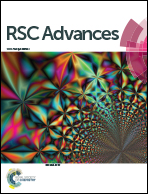Novel carbon-incorporated porous ZnFe2O4 nanospheres for enhanced photocatalytic hydrogen generation under visible light irradiation†
Abstract
Carbon-incorporated ZnFe2O4 nanocomposite photocatalysts with porous spherical structures have been synthesized by a modified solvothermal method combined with a post-calcination process using polyvinylpyrrolidone (PVP) as a carbon source. Microscopy morphology studies show that the ZnFe2O4 nanospheres with a porous structure and diameter within the 100–200 nm range were constructed by plenty of nano-sized primary particles. Fourier transform infrared, Raman and X-ray photoelectron spectra indicate the presence of graphite-like carbon on the ZnFe2O4 nanospheres, which can serve as effective transport channels for photon-excited electrons from the surface of the photocatalysts and suppress the recombination of photogenerated electron–hole pairs with its superior electrical conductivity. Without noble metal loading, the ZnFe2O4–carbon nanocomposites show a higher photocatalytic activity towards hydrogen production than individual ZnFe2O4 under visible light irradiation (λ > 420 nm). It is concluded that the effort provided a new approach to fabricate carbon-incorporated ZnFe2O4 nanocomposites, also expanded the application of ZnFe2O4 nanospheres as visible-light excited photocatalysts for hydrogen production.


 Please wait while we load your content...
Please wait while we load your content...